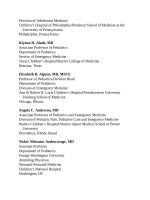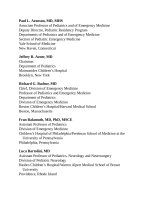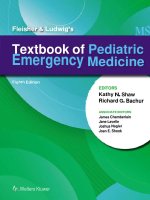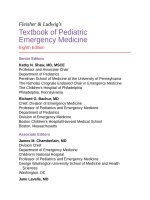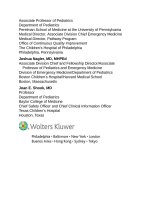Pediatric emergency medicine trisk 0221 0221
Bạn đang xem bản rút gọn của tài liệu. Xem và tải ngay bản đầy đủ của tài liệu tại đây (101.54 KB, 1 trang )
signs of shock (poor end-organ perfusion) and treat with isotonic crystalloid
boluses even if the blood pressure is normal.
The 2015 AHA Guidelines Update newly recommended caution in the use of
fluid boluses for children with a severe febrile illness who are in settings with
limited access to critical care resources, as they may be harmful.
Hypertonic saline causes an osmotic shift of fluid from the intracellular and
interstitial spaces to the extracellular compartment, providing rapid volume
expansion with less interstitial edema. In addition, less volume is required
allowing the bolus to be completed in a shorter period of time. Hypertonic
solutions are also believed to reduce ICP by establishing an osmotic gradient
across the blood–brain barrier that draws water from the brain into the vascular
space. Conversely, potential detrimental effects include continued hemorrhage
from injured blood vessels, and increased ICP due to leakage of sodium through a
disrupted blood–brain barrier. Currently, data does not support the use of
hypertonic saline over isotonic crystalloid for the resuscitation of hypovolemic
patients.
For hemorrhagic shock, current Advanced Trauma Life Support (ATLS)
guidelines recommend considering “crystalloid-restrictive balanced blood product
resuscitation” for patients with hemorrhagic injury, although current studies in
pediatric patients are lacking at this time. Application of this being a single 20mL/kg bolus, followed by a weight-based blood product administration.
Serum albumin concentration has been shown to be inversely related to
mortality risk. Thus, its use in the resuscitation of ill patients has been explored. It
is 30 times more expensive than crystalloid solutions and has limited availability.
Systematic reviews have failed to show benefit from its administration. Albumin
is believed to have some anticoagulant properties and may leak across the
capillary wall, promoting edema.
DEFIBRILLATION AND CARDIOVERSION
The true prevalence of VT and VF in children with cardiopulmonary arrest in
published reports is approximately 10% in both IHA and OHCA pediatric arrest (
Table 9.7 ). An additional 10% to 15% will develop VT/VF as a subsequent
rhythm. Although the need for defibrillation is relatively uncommon, it must
always be considered in arrest, especially in older children, children with a
history of congenital heart disease or dysrhythmias, and children who experience
a witnessed sudden collapse arrest. Interestingly, a secondary analysis of the
CARES registry found that though younger children (1 to 8 years) with OHCA
had a relatively low incidence of an initial shockable rhythm (11%) as expected,




